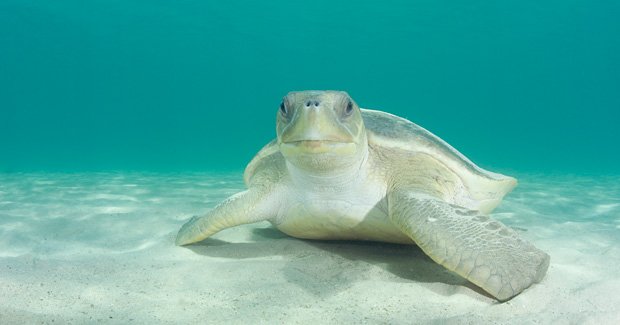Flatback turtles filmed underwater for first time

PHOTOGRAPHER DOUG PERRINE and I stand side by side, eyeing the ocean. It’s just plain crazy to be out here at midday. The blistering heat is relentless. The lava-hot sand on the beach burns through our wetsuit boots as the scorching wind sandblasts our backs, needling around into our eyes, ears and mouths.
We’ve covered every inch of skin to avoid severe sunburn or heatstroke. Dehydration and exhaustion are other hazards. Crazy it may be, but we need direct sunlight for maximum visibility underwater and, with storm warnings out, it’s now or never if we want to achieve an 11-year dream of capturing the first professional underwater photographs of an adult flatback sea turtle.
I discovered the flatback’s underwater behaviour while researching with AusTurtle at this turtle-nesting site, off the remote north coast of Australia. The spot is unusual as it doesn’t have the normal swirling plumes of muddy sediment to cloud the water and so we’ve been given a rare opportunity to spot and photograph these mysterious mariners in clearer water.
More than turles: sharks, crocodiles and jellyfish too
But we’re not the only ones searching for these turtles. Sightings of aggressive tiger sharks and large hammerheads are common here, not to mention saltwater crocodiles and deadly jellyfish. Flatbacks are a perfect bite-sized meal for a tiger shark, and we would be helpless if we were mistaken for a turtle – but our determination to capture these elusive creatures on camera outweighs any trepidation.
We don our snorkel gear and make our way along a vast reef edge, jumping at shadows and stealing quick glances behind us to see what’s following. We’re traversing a current and we’re soon separated. I note Doug’s position and swim on.
The swell stirs up sand, reducing my visibility and it feels creepy. I want to see what’s coming. I try to forget what might be out here with me and keep finning. Suddenly, I come across a mound of rock in a sandy clearing, but as I get closer I make out a turtle shape. I grin around my snorkel. A large female flatback turtle is sitting serenely on the bottom below me, covered in a fine layer of sand (above). This is the photographic opportunity we have both been hoping for.
Flatback turtle first
I look up over the wind-whipped peaks of water and signal frantically to Doug using our agreed ‘T for turtle’ arm movement. He is 50m further out lugging the photographic equivalent of a moose head (antlers and all) behind him, through the surging current. His unwieldy underwater camera and strobe unit is protesting with all its might as he pulls it through the choppy surf.
I keep one arm in the air to help him locate me in the increasing swell. I fight to stay with the turtle in the strong current, which is pulling me further out to sea.
Doug’s progress is slow. I am anxious; will he make it before she has to get to the surface to breathe? Doug arrives, spots her and wastes no time in free-diving down to get some photos. She is the perfect model, but not wanting to spook her, we keep our distance, noting that she has scooped sand over herself as camouflage, and is probably sitting on the bottom to lessen the chance of an attack from beneath. She appears relaxed, but does not take her eyes off us. Doug moves towards her and she graciously allows him to take a range of photos.
Australia’s only endemic turtle
After several minutes she shifts and slowly lifts to the surface to breathe before ducking back under. She is incredibly trusting as she is highly vulnerable while swimming in open water. She propels herself forward effortlessly with small beats of her flippers, in search of another suitable sandy spot. We swim alongside her for a minute or so, and then leave her in peace as she swoops off back into the gloom.
With a set of precious photos in the bag we slowly head back to shore. We drag ourselves from the water exhausted but euphoric. What a fantastic feeling to finally interact with this precious turtle and emerge from the perilous ocean with all limbs fully intact.
Source: Australian Geographic, Issue 108 (May – Jun, 2012).
RELATED STORIES

